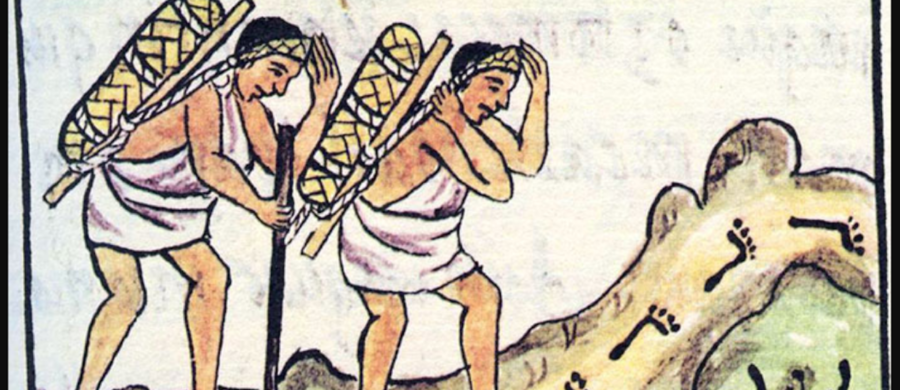
Conserving the American Tropics: Exploring the Cropscape of the Ancient Maya
Technology’s Stories vol. 9, no. 1 DOI: https://doi.org/10.15763/jou.ts.2021.03.23.01
Ford et al
Introduction
The environmental legacy of the ancient Maya is a controversial topic. Since at least the 19th Century, when widely published travelogues began revealing the wondrous monuments of Maya cities to Euro-American audiences,[1] Western popular imagination has been captivated by Maya civilization, and especially tales of its demise. Collapse narratives frequently invoke primitive cultivation techniques, fragile tropical forests, and environmentally destructive lifeways as driving the downfall of Maya kingdoms, but these explanations more often hinge on ecological imperialist prejudices than empirical observations.[2] Our research, conducted in partnership with traditional Maya farmers – the master forest gardeners – suggests these stories miss the mark. Indigenous agricultural practices and ecological knowledge developed over millennia in the Maya Forest of southeastern Mesoamerica (see figure 1), actually increased resilience to climate change while providing all household necessities for ancient populations. A shift in mindsets and willingness to challenge received wisdom are requisite to begin exploring sustainable living solutions from the Maya past that can address our future challenges.
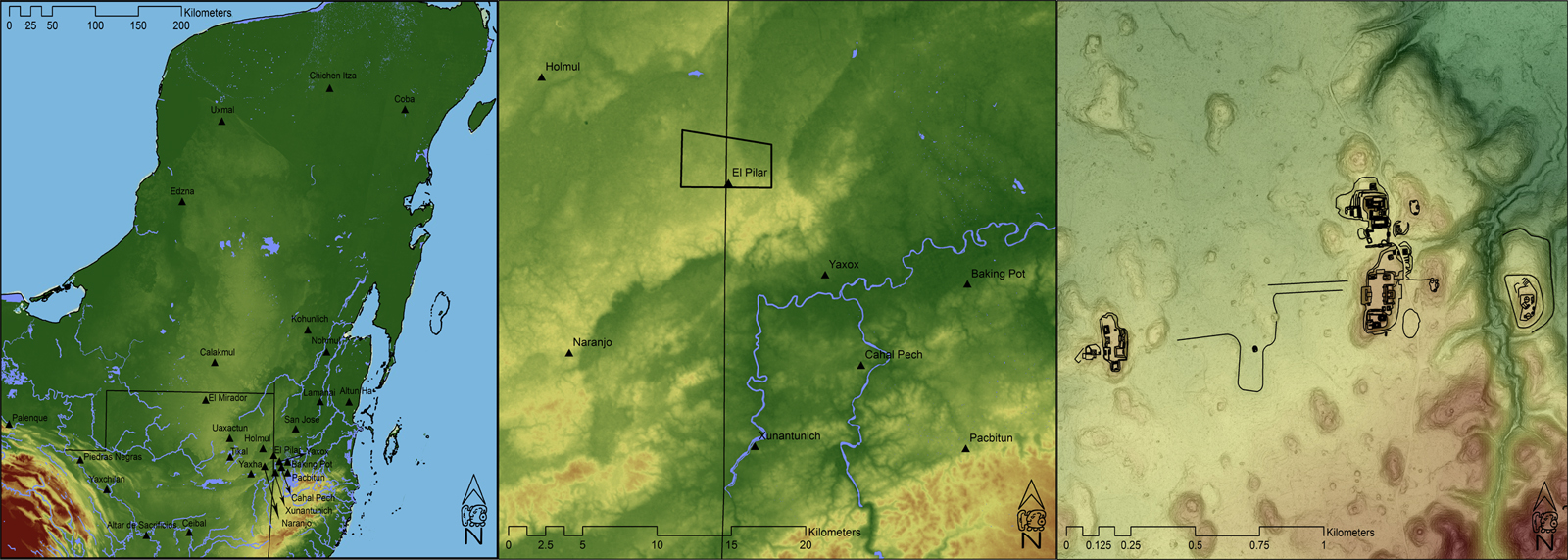
Figure 1A: The Maya Area at Different Scales: Region, Local, and Site (El Pilar). Credit: MesoAmerican Research Center; Thomas Crimmel
Figure 1B: Maya Forest Atlas Web App. Credit: MesoAmerican Research Center; Claudia Knudson
Theoretical frameworks for understanding the “Maya Collapse” – which have incorporated data from advanced scientific techniques in recent years – envision Maya societies becoming increasingly vulnerable to climate change, as their environment was degraded and deforested by growing populations and unsustainable agricultural practices.[3] The robust archaeological record and long-enduring Indigenous understandings of forest ecology and food production,[4] however, suggest different interpretations that warrant exploration. The Maya Forest is among the most diverse in the world,[5] and its dominant trees are economically valuable in both local and global markets.[6] These contemporary forest features reflect long-term land-use choices that we must decipher to make sustainable living a reality in the area today.
The topic of tropical forest conservation may seem esoteric to those from temperate latitudes, and the connection to archaeology may not be apparent at first.[7] Tropical forests have long been viewed as marginal environments for human occupation – their soils termed fragile and infertile, their land unworkable for food production without the technology of industrial agriculture[8] – yet they are now at the forefront of a population explosion, with massive growth and development forecast for the coming decades.[9] The Maya Forest, a biodiversity hotspot[10] second only to the Amazon, now faces grave risks from the expansion of industrial plantation agriculture. The top-down imposition of Euro-American agricultural systems,[11] based on pasture and plow, has created the very conditions of deforestation and environmental degradation invoked to explain the Maya collapse (see figure 2). How, then, can archaeology inform debates about sustainable development and human population expansion in the tropical forest?

Figure 2: Landsat composite image of the Mexico-Guatemala border showing differences in deforestation[20]. Credit: Assembled by MesoAmerican Research Center.
We consider the contemporary Maya Forest as the product of human-environment interactions over millennia – not as a wild or pristine jungle,[13] but as a cropscape shaped by human hands[14] and an integral component of successful land-use technologies.[15] By documenting how the ancient Maya settled their landscape, and assessing these settlement patterns in light of traditional food-production and forest-management techniques,[16] our team of archaeologists, ethnologists, geographers, botanists, wildlife biologists, geologists, volcanologists, advocates, and citizen scientists are beginning to reveal how this remarkable civilization was able to thrive in the tropical forest for generations.[17] Recognizing the potential of Maya land-use strategies to create a vibrant, diverse, and economically bountiful cropscape[18] can yield insight into critical concerns facing communities throughout the world today, such as the need to conserve water, reduce erosion, build soil fertility, lower temperatures, maintain biodiversity, and provide people a high quality of life.[19] To understand how the ancient Maya and their descendants developed subsistence technologies that shaped the forest – and how these might be employed for contemporary conservation and sustainable development – we must examine the Maya Forest environment and the history of humans on the landscape.
The Mesoamerican Tropics and the Creation of the Maya Forest Cropscape
The Maya Forest is situated in the southern lowlands of Mesoamerica, spreading across 54,000 km2 of the modern-day countries Belize, Guatemala, and Mexico in the Yucatan Peninsula.[21] Large rivers flank this area to the east and west but do not traverse its extent; lakes are concentrated near its geographic center but are otherwise uncommon. A combination of permeable limestone bedrock, which absorbs surface water, and a karstic topography of ridges and low-lying troughs creates a complicated landscape mosaic, comprising well-drained uplands and perennial wetlands with transitional areas between. Well-drained soils of the rocky ridges and hills, supporting the greatest diversity of broadleaf forest vegetation and particularly prized by ancient and modern people,[22] cover about 30% of this region, while poorly drained wetland soils overlay around 40% of the land (see figure 3). Variation in the physical environment, along with the restricted nature of available surface water, produces a range of habitats for plants and animals and provides a foundation for the biodiversity seen in the area today.
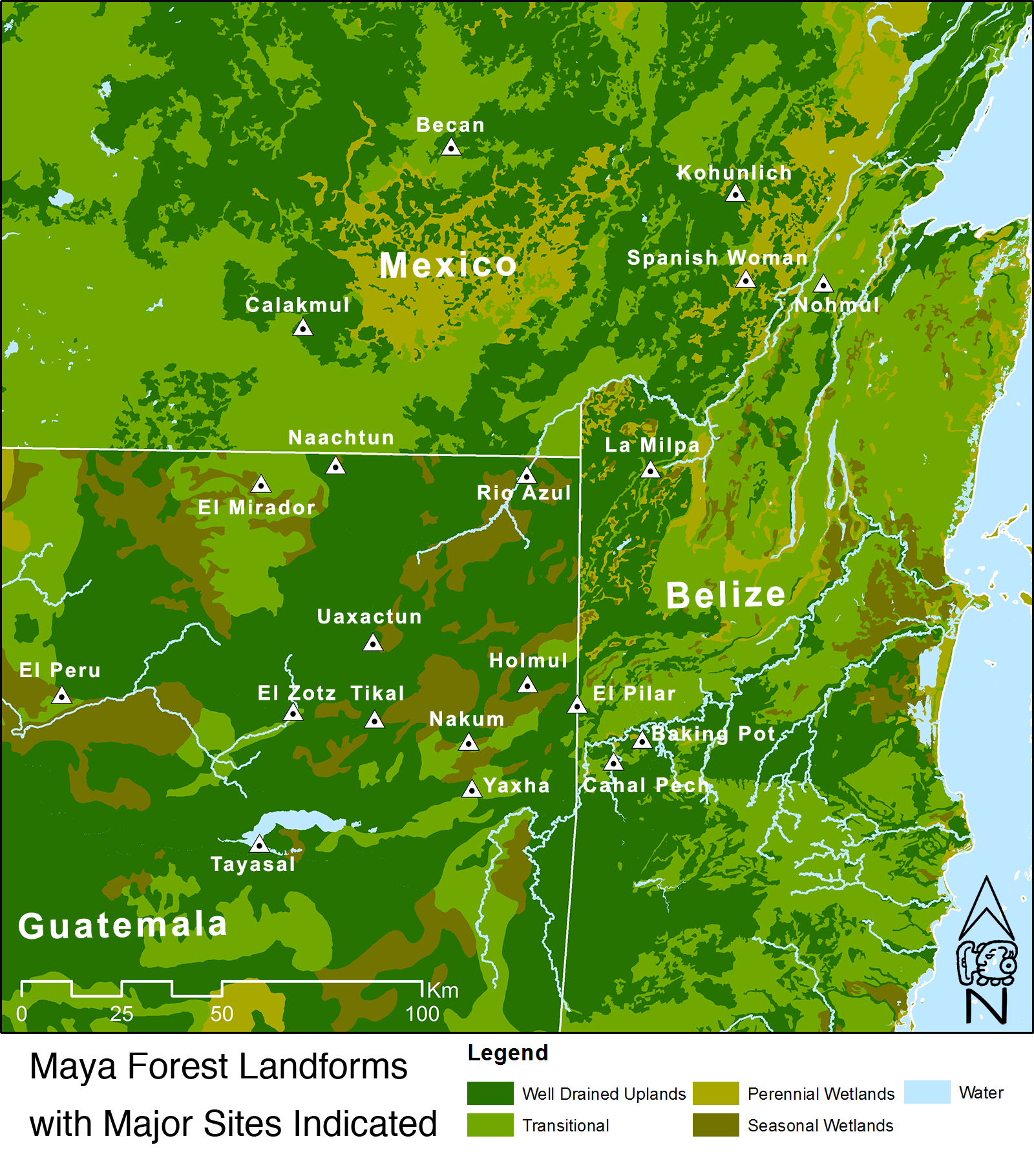
Figure 3. Landforms of the Maya Lowlands with major sites indicated (including Tikal and El Pilar). Credit: MesoAmerican Research Center
Maya settlements emerged in the tropical forests of the Yucatan Peninsula more than 3,000 years ago and, over the ensuing centuries, developed into one of the world’s great pre-industrial civilizations.[23] The expansion of Maya populations – along with increasing organizational complexity in their communities – was underwritten by adaptations to the tropical forest environment that sustained growth and development for millennia.[24] Indeed, part of the enduring public fascination with Maya civilization seems to derive from the circumstances of its development. How could a literate society, with notable achievements in mathematics, astronomy, architecture, and fine arts possibly have arisen in the ‘inhospitable’ Mesoamerican jungles? This view reveals a fundamental, cultural bias in Euro-American understandings of both the tropical forest and its occupants, and it obscures another great technological achievement: the creation of the Maya Forest cropscape.
The story of how humans adapted to life in the Yucatan Peninsula, and ultimately created a verdant and resilient environment in the Maya Forest, pre-dates by thousands of years the pyramids, temples, and hieroglyphs associated with Maya civilization. In fact, this story begins even before tropical forests became the dominant ecosystems in the region. Recent archaeological evidence from submerged caves near Mexico’s Caribbean coast and caverns in the mountains of southern Belize indicate people had entered the area perhaps 15,000 years ago, when global climate regimes were cool and dry at the end of the Pleistocene Epoch, popularly known as the Ice Age. These migrants arrived from Asia, and their technology – based on manipulating stone and fire – allowed them to spread across the American continents in some 2,000 years (see figure 4).

By 8,000 years ago, global trends toward warmer and wetter climates created ecological shifts across Mesoamerica, especially in the lowland region that later fostered Maya civilization. These shifts changed the environment to a complex, biodiverse tropical forest ecosystem well-suited to support human communities. Opportunities presented by such dramatic environmental changes were accompanied by challenges for the early inhabitants of the Maya Lowlands, who had embraced a mobile way of life well-adapted to Pleistocene conditions. Pioneering communities unlocked the potential of their new landscape, developing food-production and resource-management strategies that involved both domesticated crops and forest species. These strategies left an enduring impact on the Maya Forest that is conspicuous to this day.
The history of the earliest food production in the Maya Forest is still being written.[25] Early tropical forest dwellers were mobile horticulturalists who left few traces of their presence and no remains of permanent settlements. Evidence indicates that people in the Maya Lowlands cultivated maize and other crops, but the processes of integrating domesticated plant use with forest products remain unknown. Despite it being but one of many plants that provided sustenance for the Maya and their ancestors, maize – the Mesoamerican grain – captured the attention of Spanish conquistadors and is a global staple today.[26]
People learned through trial and error to use available technology in concert with abundant natural resources to produce the food and other materials necessary to live in the tropical forest. Experiments manipulating the ecology of plants and animals, based on observations of natural forest succession, began a process of accumulating knowledge for effectively using the environment to benefit human communities. An outcome of these early human-environment interactions was the development of the Indigenous production system known as the Milpa Cycle, which continues to be practiced and refined by forest gardeners in the Maya area today (Figure 5).[27] The language of the Maya Forest and the knowledge of how to manage food production and resources in a tropical forest setting were integral to supporting millions of Maya people at the apogee of their civilization. The Milpa Cycle may prove key in developing sustainable plans for the tropics today.
Figure 5: Maya Forest Gardens and the Milpa Cycle Maya Forest Garden Web App.
Credit: MesoAmerican Research Center, Bianca Graves
The Forest Cropscape: The Domesticated Landscape of the Milpa Forest Garden
Debates about the viability of the tropical forest to sustain ancient Maya civilization are not new, but our perspective here is original; the relationship between soils and Maya land-use technology serves as an example to illustrate our frame of reference. Rocky soils are considered undesirable in European cultivation systems centered on the plow – a tool not used in the pre-Conquest Americas – and it was inconceivable to non-Indigenous observers that the ‘primitive’ Maya cultivation system could support large populations and complex societies without destroying the shallow tropical soils (see figure 6). This view discounts the knowledge, skill, and labor that form the foundations of Indigenous food production and fails to appreciate the productive potential of soils – dubbed ‘uncultivable’ by non-Indigenous assessors[28] – when managed with traditional methods.[29] Consequently, archaeologists and others have presumed that overpopulation, leading to excessive agricultural demands, precipitated societal collapse and the abandonment of cities.
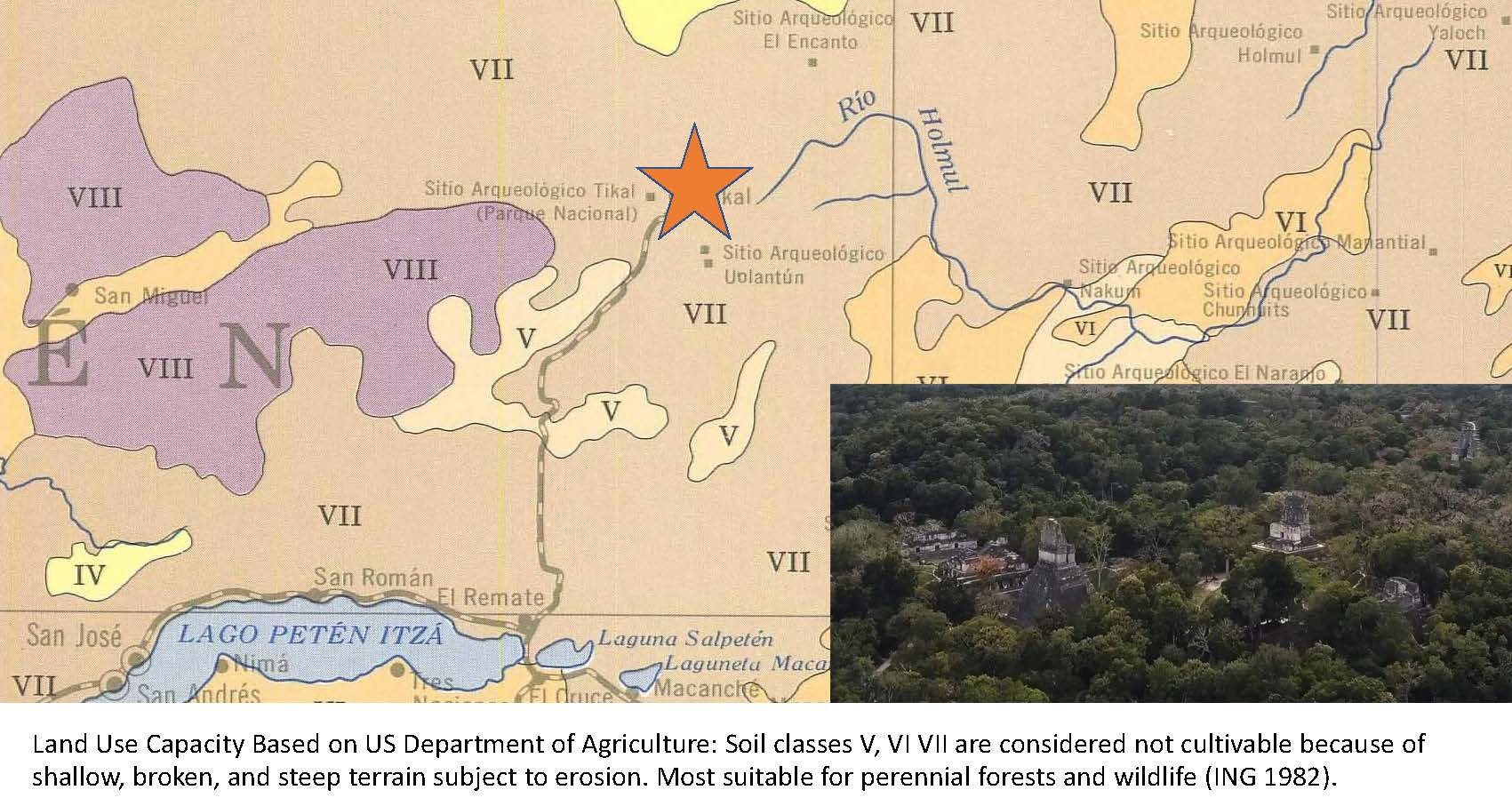
Figure 6: Where were the Maya cultivating? The US Department of Agriculture classification shows all soils around the major ancient Maya center Tikal as Not Cultivable.[30] Assembled by MesoAmerican Research Center, Instituto Geografico Nacional de Guatemala 1982
Introducing the Milpa Cycle: From Field to Forest and Back Again
A popular perception holds that slash-and-burn fields – components of the Milpa Cycle in Mesoamerica and the Maya area – are responsible for destroying forests.[31] By focusing on domesticated crops and the fields they are grown in, ecological imperialists only see shifting agriculture and discount the majority of the landscape as ‘abandoned.’ In fact, traditional Maya land use has a deep history, but these practices have been deliberately dissociated from the living Maya by adherence to imperialistic views. These views deny the obvious connection between the contemporary Maya and their ancestors (see figure 7).[32]
Figure 7: Milpa Cycle, An Odyssey Film: http://www.odysseyearth.com/videos/sustainable-farming-the-maya-milpa-cycle/ Credit: Odyssey Film
Contrary to this perspective of an abandoned landscape, studies show that the forest today was shaped by practices developed by the Maya millennia ago.[33] The ancient Maya maintained their environment while using it to provide food, shelter, medicine, and other necessities of daily life. The Milpa Cycle – a complex and sustainable sequence that alternates between cultivated fields and forest gardens – builds a useful cropscape that can sustain human life and maintain the biodiversity of the forest.[34] Contemporary Maya forest gardeners draw on the knowledge of their predecessors to preserve the forest as a garden.[35]
The Maya Forest reflects countless generations of managed crop cultivation and directed succession of perennial forests. As a result of this careful curation of the forest as a cropscape, the Maya Forest is today among the most biodiverse in the world, filled with plants valued for the economic uses and the habitats they provide.[36] This wealth untold is both a cultural and economic treasure, representing millennia of short- and long-term choices of planting annual crops and perennial trees to sustain the needs of Indigenous Maya communities (see figure 8).
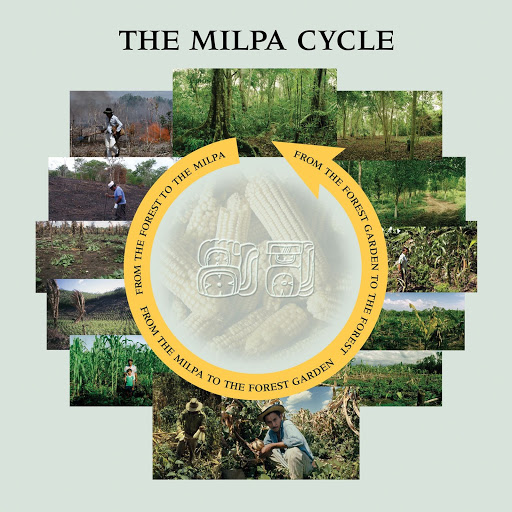
Figure 8: The Milpa Cycle creates field gaps to build the forest as a garden. Credit: MesoAmerican Research Center
The ancient Maya cultivated their landscape in ways that prioritized usefulness and complemented natural forest cycles. Collaborations with contemporary Maya farmers reveal a sophisticated knowledge-base that contributes to the continued maintenance of the forest as a garden.[37] The average 20-year Milpa Cycle is tethered to the infield home gardens that are the hub of the outfields. The system is characterized by a rotation, starting with open fields of traditional agricultural crops, progressing through a sequence of products obtained from secondary growth, and completing the circuit with a closed canopy forest over the original cleared area that is ready to repeat the cycle again (see figure 9).
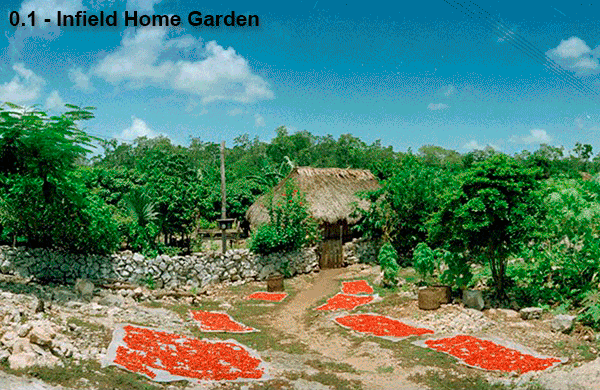
Figure 9: Milpa Cycle Photo Sequence: 1. Infield home gardens; 2. Outfield preparation, planting, and harvests of annual; 3. Forest succession of building and maturing perennials; and 4. Managed forests. Credit: Photography Macduff Everton.
The choices of farmers in selecting plants account for the dominance of economically useful species across the extent of the Maya Forest (see table 1), as generations of Maya agriculturalists applied their knowledge to meeting community needs. Forest gardening strategies have also developed to be responsive to climate change, as the predominantly forested landscape and poly-cultural fields constantly maintain land cover in ways that enhance biodiversity, conserve water, and moderate temperatures. These common land-use practices also help retain organic matter, which contributes to soil fertility and reduces erosion. The outcome is a managed cropscape that can support the diverse daily, monthly, seasonal, and annual economic necessities of people living in the forest.
Table 1: Dominant Plants of the Maya Forest ~ Their Pollinator and Uses
| Common
Name |
Scientific
Name |
Pollinator
Syndrome |
Primary
Uses |
| Bay Leaf | Sabal morrisian* | insects | Food, Production |
| Breadnut | Brosimum alicastrum* | wind | Food, Fodder |
| Cabbage Bark | Lonchocarpus castilloi | insects | Construction |
| Chicle | Manilkara zapota* | bats | Food, Latex |
| Cohune | Attalea cohune * | insects | Food, Construction |
| Drunken Baymen | Zuelania guidonia | bees | Medicine |
| Fiddlewood | Vitex gaumeri | bats | Construction |
| Give-and-Take | Cryosophila stauracantha | beetles | Production |
| Guaya | Talisia oliviformis* | bees | Food |
| Gumbolimbo | Bursera simarouba* | bees | Medicine |
| Hogplum | Spondias radlkoferi | insects | food |
| John Crow Redwood | Simira salvadorensis* | moths | Construction |
| Mahogany | Swietenia macrophylla | insects | Construction |
| Mamee Ciriola | Pouteria campechiana | insects | Food |
| Mayflower | Tabebuia rosea | bees | Construction |
| Monkey Apple | Licania platypus | moths | Food |
| Mylady | Aspidosperma cruentum | insects | Construction |
| Wild Mamey | Alseis yucatanensis | moths | Food |
| Wormwood | Piscidia piscipula | bees | Poison |
| Zapotillo | Pouteria reticulata | insects | Food, Latex |
*dominant in contemporary gardens
The Milpa in Detail
Milpas are regularly equated with planted fields, but in truth, those fields are but one part of a cycle that invests in long-term perennial growth by clearing land in the short term. The home infield is the most intensively attended part of the system (see figure 10), and its products are complemented by necessities from the surrounding cropscape. The integration of Milpa Cycle elements is so complete that master forest gardeners say there will be no forest without the fields, and no fields without the forest. By recent estimates, the Maya use some 500 plants from their fields and forests as food,[38] and they favor around 200 different trees for various and sundry uses.[39]
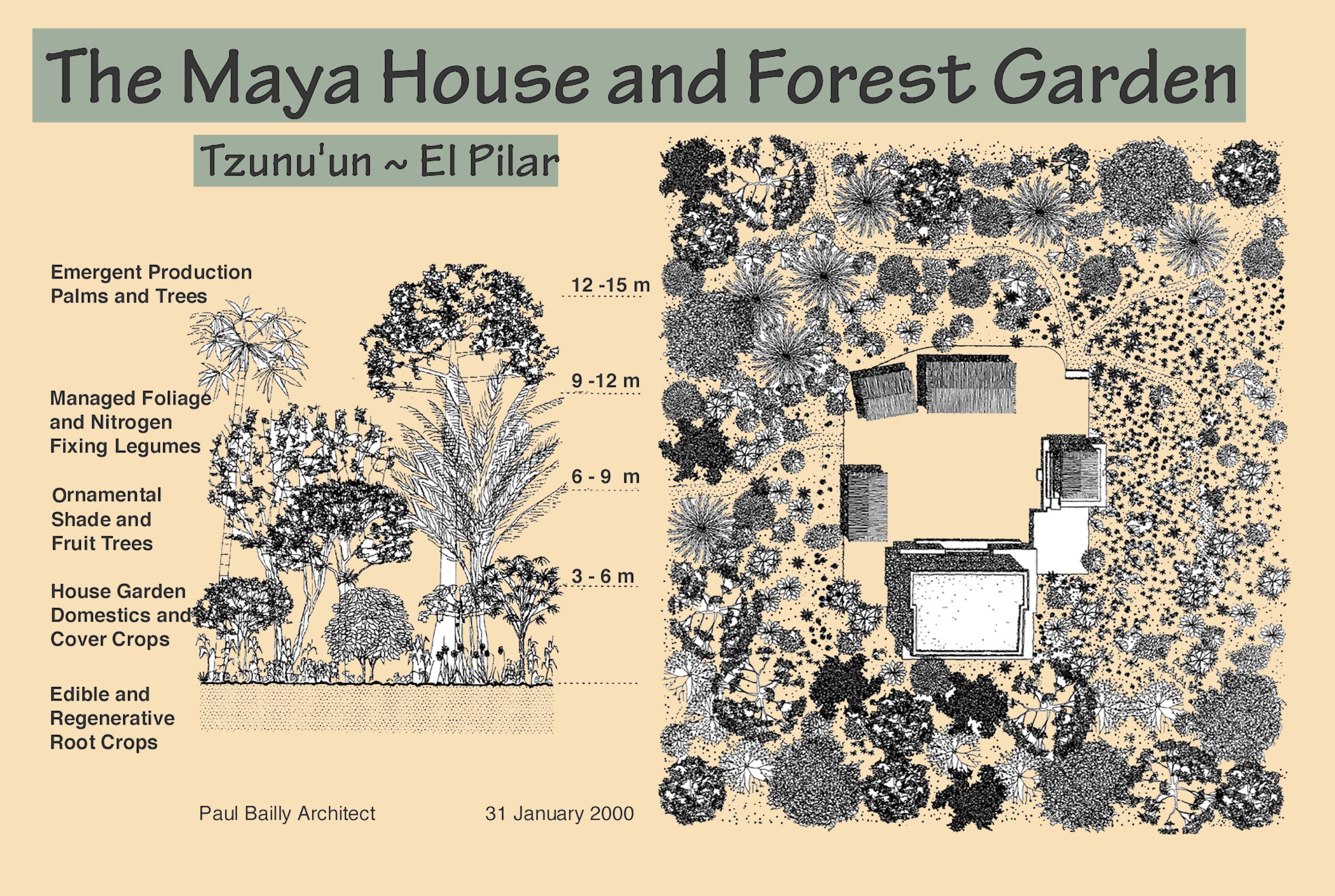
Figure 10: Profile and Plan Schematic of a Maya House and Forest Garden Infield. Credit: MesoAmerican Research Center.
Open fields provide gaps that are intermingled with and surrounded by areas of perennial succession and closed-canopy forest.[40] Farmers selectively cut trees with resprouting in mind, favoring and preserving those that usefully hasten the transition to succession perennials.[41] Slashed fields are then burned to clear an area for sun-loving, annual food crops, which are fertilized by nutrients left in the soil from ash. Maize, beans, and squash, the ‘three sisters’ of New World fame, lead the variety of crops selected for each milpa field. It is not unusual to find more than 30 different crops in one field, however, which are chosen from a basketful of more than 100 possibilities.[42] This poly-cultural field is sustained for about four years of a minimum 20-year cycle, all the while fostering selected perennial trees that emerge with the natural cycle of forest succession.
Over the next sixteen or more years of the Milpa Cycle, Maya farmers today promote a variety of useful perennials, starting with fast-growing trees, such as papaya, and other economically useful succession saplings.[43] These provide shade for a diversity of slow-growing fruit and hardwood trees that emerge over the remaining eight years and form the new shade canopy. Many of these trees – palms for oils and construction; avocado, ramon, allspice, mamey, nance, and cacao for fruits; and mahogany, cedar, and manchiche for lumber, to name but a few – will mature to build a functional forest garden, providing for the needs of people as well as habitats for wildlife.[44] After the cycle is completed, new farmers follow in their fathers’ footsteps – nurturing favored trees, burning fields, inviting new sprouts to aid the transition of clearings to shady forests – and the process begins anew (see figure 11).
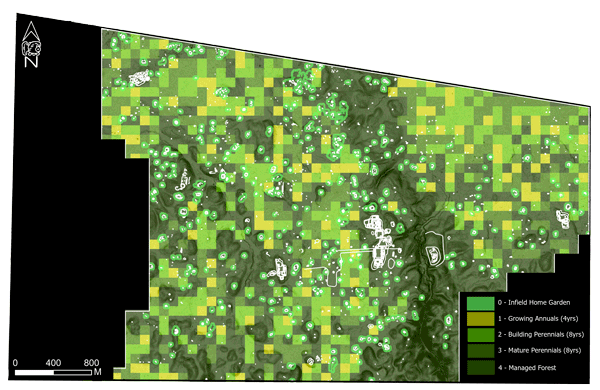
Figure 11: Animation of the 20-year Milpa Cycle on the landscape of the ancient Maya Center of El Pilar. The patterns include: 0. Fixed infield home gardens around residential units, and outfields sequencing from 1. Four years growing annuals, 2. Eight years building perennials, 3. Eight years mature forest all within the context of 4. Managed forests. Credit: MesoAmerican Research Center, Justin Tran and Jason Woo.
The Western concept of agriculture views intensification as expanding fields at the expense of the forest, following a zero-sum mentality of culture versus nature (see figure 12A). While it features so prominently in the focus on shifting agriculture, the open fields of the Milpa Cycle will only compose, on average, one-fifth of the total cropscape (see figure 12B). The majority of the cropscape will emphasize the perennial component found in phases of forest succession, which provide for the numerous needs of community members (see figure 13). Across generations, the open fields of annual crops are transformed into useful forest gardens, creating a nurturing, productive, and biologically diverse landscape. The milpa-forest garden system is primarily practiced in well-drained places on the landscape, leaving the majority of wet and steep areas as managed forests. Maya forest gardeners demonstrate a finesse with nature, cultivating biological capital from their surroundings as a product of their culture.
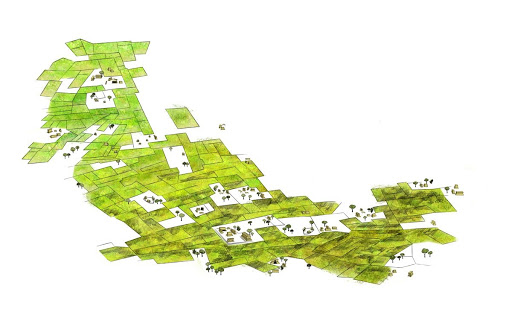
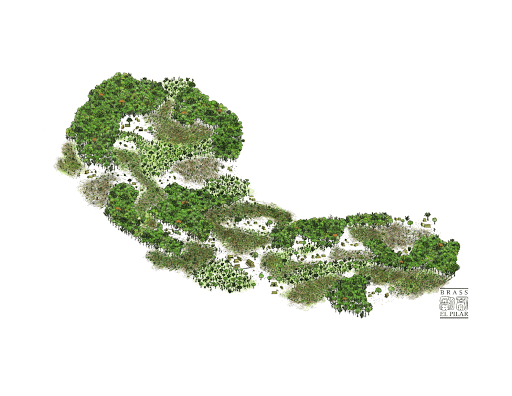
Figure 12: Ecological imperialist view compared with the dynamic Milpa Cycle: A: Fields reminiscent of 1066 Normandy vs B: The dynamic Milpa Cycle. Credit: MesoAmerican Research Center
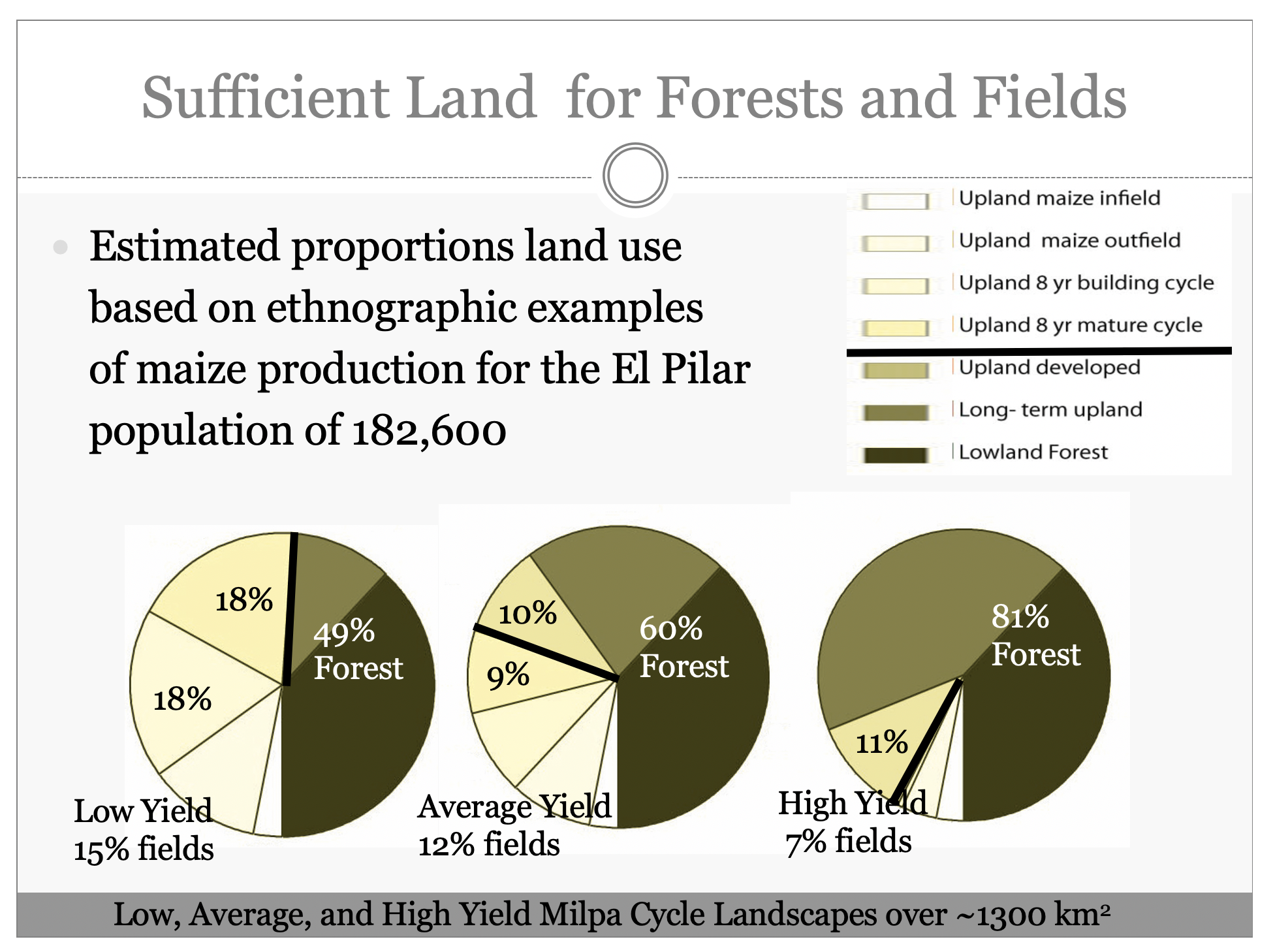
Figure 13: Forest-Fields proportions for the El Pilar area based on example yields. Credit: MesoAmerican Research Center
Forest Gardens | Action for Climate Change & Food Sovereignty
The Maya were an agricultural society that relied on the basic technologies of stone tools and fire. They moved through the landscape on foot (see figure 14), observing their environment while walking and learning crucial lessons in the footsteps of their elders.[45] Maya farming practices – based on family knowledge, skill, and labor[46] – generated complex relationships between communities and the environment they inhabited, and the growth and development of these communities through time provides ample proof that those practices were sustainable. Yet the perspective of Maya civilization as doomed to fail by virtue of its emergence in a fragile environment continues to be promulgated, untested, as fact. The current focus on the so-called ‘Maya collapse’ discounts millennia of successful adaptations and undermines an investigation of sustainability in the tropics today. The attitude of ecological imperialists persists in pejorative views of the tropics[47] and a general indifference toward exploring what the Maya example can offer to discussions of sustainability in tropical environments.
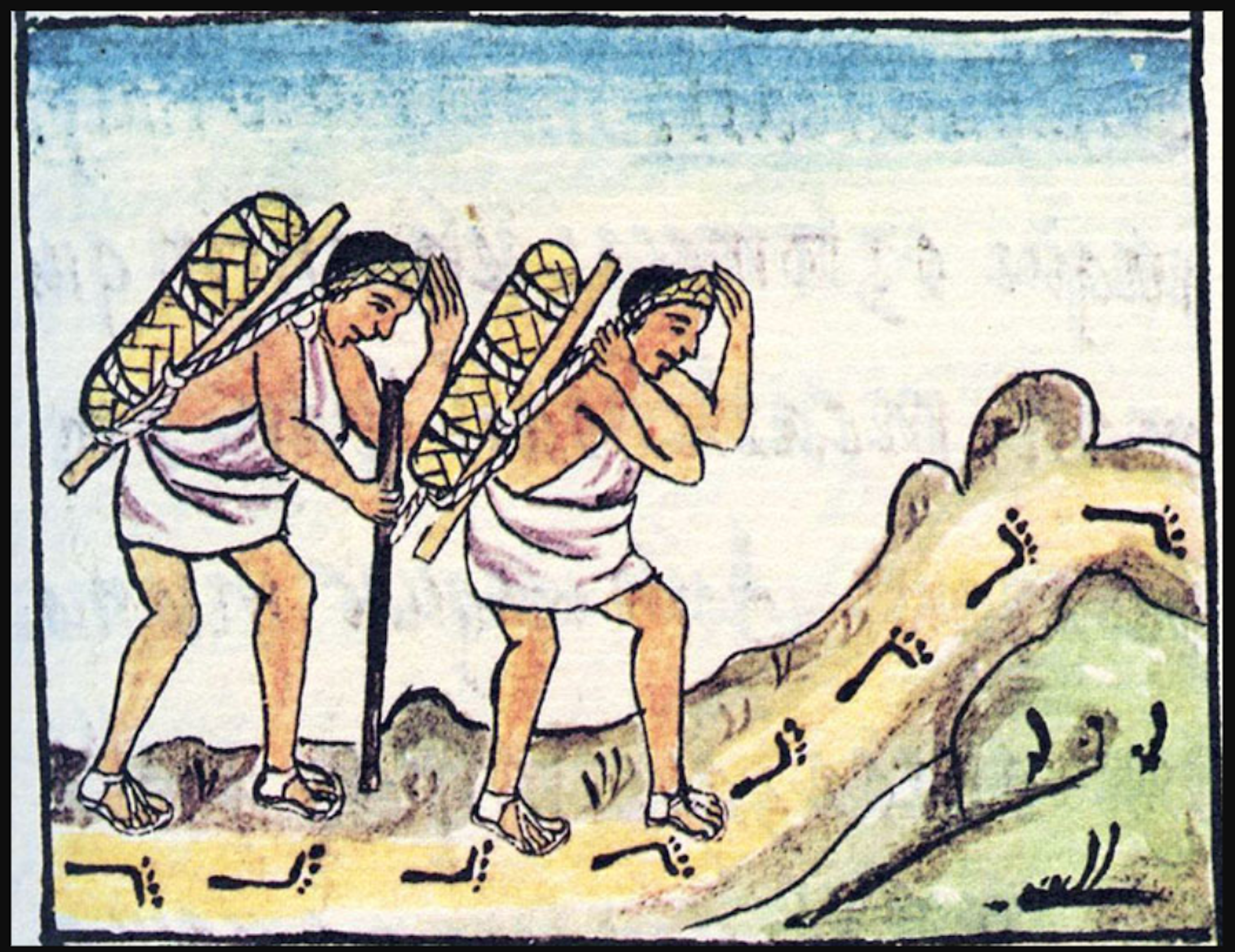
Figure 14: Mesoamerica and the Maya relied on human power to move and to transport goods, a Tumpline economy. Credit: Florentine Codex https://www.mexicolore.co.uk/aztecs/artefacts/carrying-frame
The Maya milpa-forest garden cycle provides a stimulus for exploring solutions to global issues of food sovereignty and climate change, which are critical challenges in the world today.[48] The Maya Forest cropscape comprises diverse trees that create shade to lower temperature, conserve water, and reduce erosion while producing organic matter to build soil fertility. Food produced by annuals and perennials met the subsistence needs of millions at the height of Maya civilization and could do so again. It is valuable to consider master forest gardeners as citizen scientists whose traditional ecological knowledge promotes sustainability through biodiversity, and whose traditional practices demonstrate an alternative strategy in maintaining a productive environment.
Ancient Maya monumental centers of Belize, Guatemala, and Mexico have today been “restored” to serve as popular destinations for foreign tourists. These attractions, while promoting the accomplishments of an advanced Indigenous civilization, have been divorced from the living Maya. Grandiose structures are presented as removed from their natural context. Exposing these monumental temples and palaces to the elements accelerates natural processes of architectural degradation (see figure 15). We advocate for a new way to engage with the Maya at the ancient center El Pilar, on the border of modern Belize and Guatemala, that honors past forest gardeners and challenges visitors to view the forest as a garden. Visitors to El Pilar experience the city in its forest setting in an approach we call ‘Archaeology Under the Canopy’ (see figure 16 and 17), which highlights the monuments amidst the bounty of natural resources available to provide food, condiments, fiber, oils, ornamentals, fuel, gum, medicine, poisons, furnishings, supplies, construction materials, household utensils, and habitat for animals.[49] Tourists can experience the environment represented in the language of the Maya Forest and once-common knowledge of the landscape.
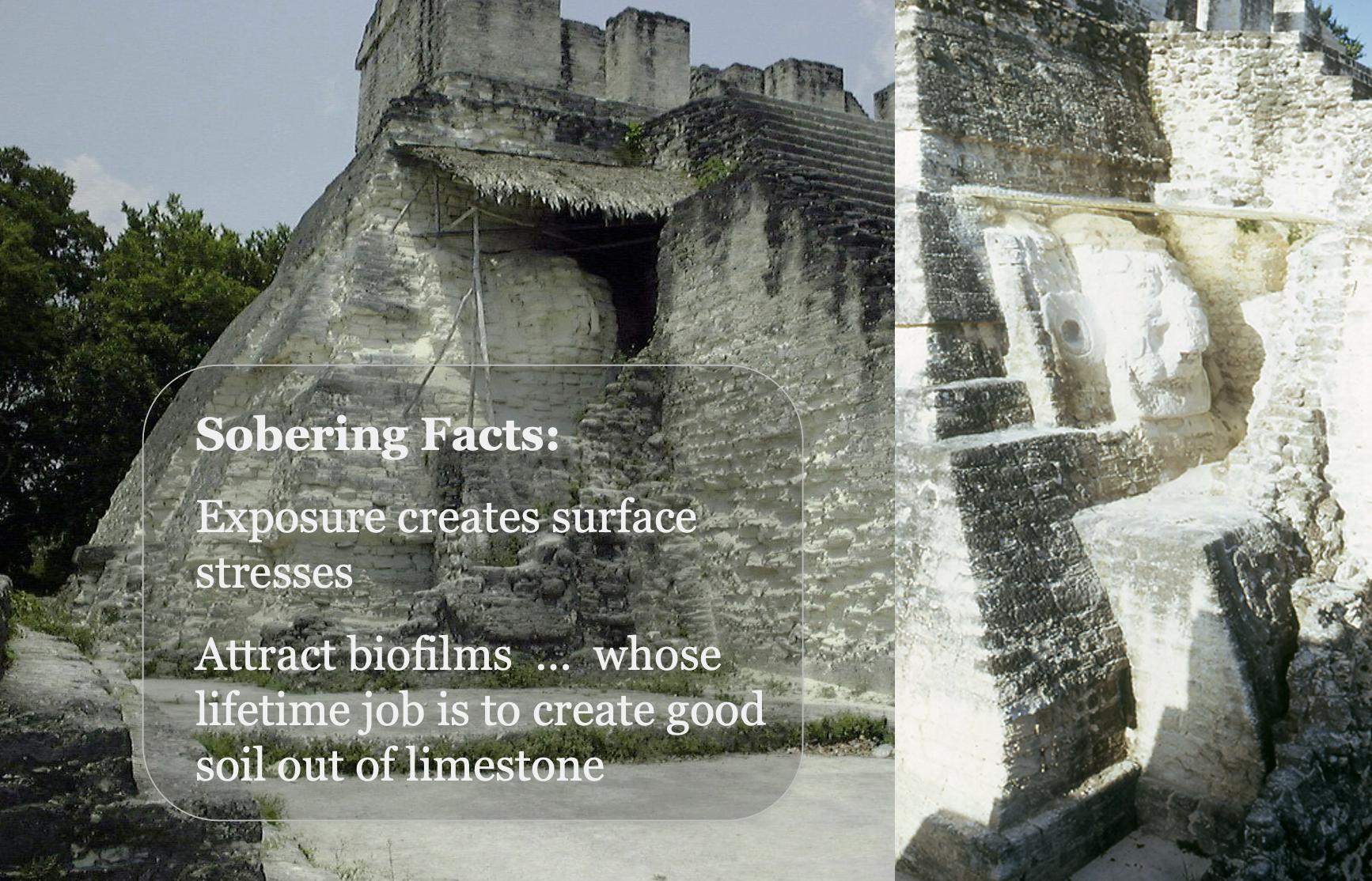
Figure 15: Clearing Monuments for Tourism, Where is the Mask? Northern Acropolis in 2012 and 1972, Tikal, Guatemala. Credit: MesoAmerican Research Center; Credit: Bianca Graves
Figure 16: An Invitation to Explore a Living Museum Archaeology Under the Canopy Web App.
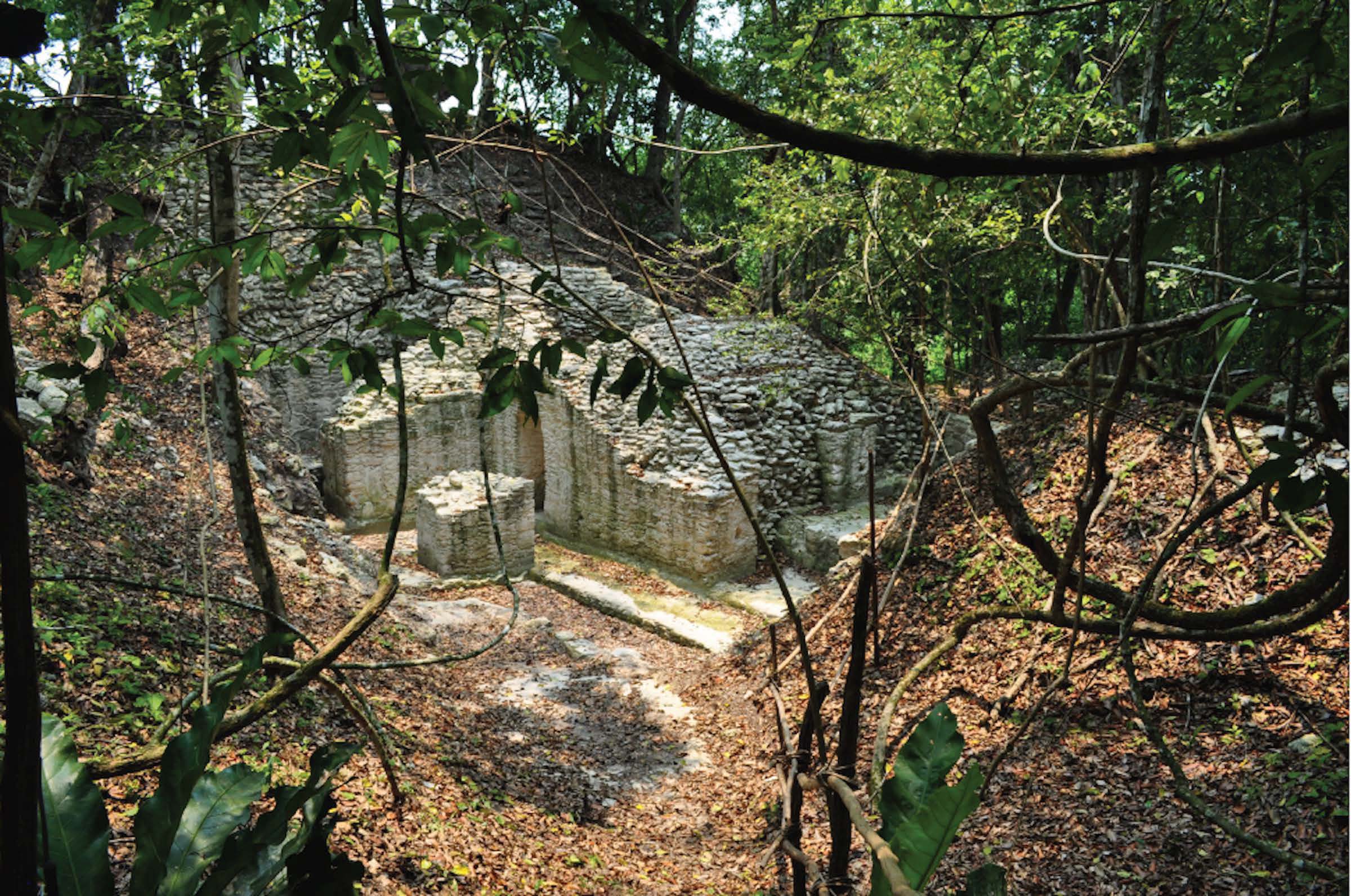
Figure 17: Archaeology Under the Canopy. Plaza Jobo, El Pilar Archaeological Reserve for Maya Flora and Fauna, Belize-Guatemala.
Long-term strategies for land management are essential in the contemporary tropics, which have endured extreme changes from deforestation (see figure 18) and are projected to host the highest levels of future population growth. Tropical forests have regularly been dismissed as fragile landscapes, and received wisdom suggests these environments are inadequate and unable to sustain large populations without substantial alteration. Yet this is the very strategy that has put the tropics at risk today. By contrast, long-surviving Indigenous food-production and land-use practices, involving sophisticated understandings of forest ecology, remind us that tropical forests are indeed hospitable environments. The Maya are one people among many who deserve recognition for creating sustainable land-use practices, and those practices should inform successful development programs in the tropics as we confront present and future challenges. The real threat to the Maya Forest is the loss of traditional Maya farming practices, for once the carriers of this knowledge are lost, it may never again be regained.
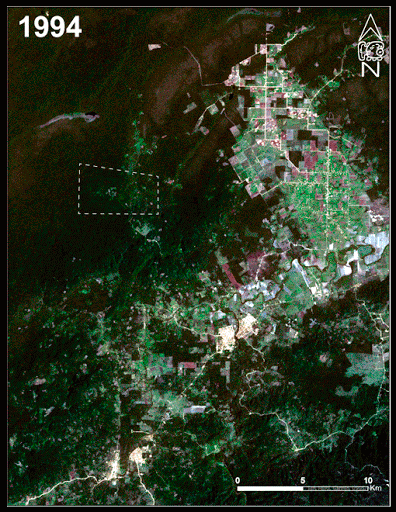
Figure 18: Landsat images of the local El Pilar area from 1994 before the establishment of the El Pilar Archaeological Reserve for Maya Flora and Fauna into the 2000s after its establishment with the expansion of the agricultural frontier of pasture and plow up to 2020.
Copyright 2021 Anabel Ford, Sherman Horn III, Thomas Crimmel, Justin Tran.
Acknowledgments
Many deserve thanks for encouraging and supporting our research. Foremost are the Institute of Archaeology, Belize, and the Instituto de Antropologia e Historia, Guatemala, which graciously permit and sustain our fieldwork in Belize and Guatemala, respectively. The directors and staff of these governmental institutions are always willing to help with project development and research. We thank our on-the-ground advocates for their remarkable work documenting ancient Maya settlement at El Pilar and sharing these discoveries with the wider community. Team members include Guatemala Co-Director Paulino Morales, Community Champion Cynthia Ellis Topsey, Master Forest Gardeners Alfonso Tzul, Narciso Torres, and Jerry Waight, archaeological collaborators Cristina Gonzalez Esteban and James Bacon, and French geospatial engineers Ludovic Adam and Juliette Lardilleux from Ecole Supérieure des Géomètres et Topographes. Claudia Knudson generously provides organizational data support for the El Pilar project, which facilitates our close collaborations with geographer Keith Clarke, botanists Nuria Torrescanno and Gerald Islebe, and soil scientist Jorge Mendoza. We are grateful to our colleagues who make this work truly transdisciplinary and to the many student interns who have trained on our project. We thank the following organizations for their support: the Anfield Nickel Corp (Lidar coverage), the National Geographic Society (development of Lidar survey protocol), New England Biolabs Foundation (forest garden community outreach), UCMEXUS (building collaborative ties with Mexican scholars), Exploring Solutions Past-The Maya Forest Alliance (maintaining the base of operations in the Maya Forest), and numerous backers at Experiment.com (fieldwork in 2017). Any shortcomings in this piece belong to the authors alone.
Anabel Ford
Anabel Ford is Director of the MesoAmerican Research Center at the University of California, Santa Barbara, and President of Exploring Solutions Past ~ The Maya Forest Alliance. Ford has investigated the major Maya center El Pilar since rediscovering the ancient city in 1983, and her work demonstrates how the Maya were able to prosper over millennia by developing distinctly local relationships to their tropical environment, which she calls the Maya forest garden.
Sherman Horn III
Sherman Horn is Deputy Director of the El Pilar research project and a member of the board of directors for Exploring Solutions Past ~ The Maya Forest Alliance. Horn directs mapping operations and works to advance the research and outreach programs of the interdisciplinary project centered at El Pilar.
Thomas Crimmel
Thomas Crimmel is a graduate student pursuing a Masters in Technology Management degree at the University of California, Santa Barbara, and a member of the Advisory Board for Exploring Solutions Past ~ The Maya Forest Alliance. Under the direction of Anabel Ford, Crimmel manages GIS operations at the MesoAmerican Research Center and his research has focused on developing methodologies for mapping environmental continuums in the Maya forest.
Justin Tran
Justin Tran will receive his BA in Anthropology in June 2021 from the University of California, Santa Barbara, with an emphasis in studying archaeology and spatial science. Tran is the internship and collections manager for the MesoAmerican Research Center and a Fellow at Exploring Solutions Past ~ The Maya Forest Alliance.
References
Altieri, M. A., & Toledo, V. M. (2011). The Agroecological Revolution in Latin America: Rescuing Nature, Ensuring Food Sovereignty and Empowering Peasants. The Journal of Peasant Studies, 38(3), 587-612. DOI: 10.1080/03066150.2011.582947
Ardren, T., & Miller, S. (2020). Household garden plant agency in the creation of Classic Maya social identities. Journal of Anthropological Archaeology, 60, 101212. doi:https://doi.org/10.1016/j.jaa.2020.101212
Atran, S. (1993). Itza Maya Tropical Agro-Forestry. Current Anthropology, 34(5), 633-700.
Avila, Macelino, Choco-Galinda, H. and Detlefsen G. (2020). Belize National Agroforestry Policy Draft November 2020. Belize Ministry of Sustainable Development, Climate Change, and Disaster Risk Management.
Blake, M. (2015). Maize for the Gods. Oakland, California: University of California Press.
Bray, F. (1986). The Rice Economies: Technology and Development in Asian Societies. New York: Blackwell.
Bray, F. (1994). Agriculture for Developing Nations. Scientific American, 271(1), 30-37.
Campbell, D. G., Ford, A., Lowell, K., Walker, J., Lake, J. K., Ocampo-Raeder, C., . . . Balick, M. (2006). The Feral Forests of the Eastern Petén. In W. Balée & C. Erickson (Eds.), Time and Complexity in the Neotropical Lowlands: Studies in Historical Ecology (pp. 21-55). New York: Columbia University Press.
Chazdon, R. L. (2014). Second Growth: The Promise of Tropical Forest Regeneration in an Age of Deforestation. Chicago: University of Chicago Press.
Cook, S. (2016). The Forest of the Lacandon Maya: An Ethnobotanical Guide. New York: Springer.
Corzo Márquez, A. R., & Schwartz, N. B. (2008). Traditional Home Gardens of Petén, Guatemala: Resource Management, Food Security, and Conservation. Journal of Ethnobiology 28(2), 305-317.
Crosby, A. W. (1986). Ecological Imperialism: The Biological Expansion of Europe, 900-1900. Cambridge, Massachusetts: Cambridge University Press.
Deevey, E. S., Rice, D. S., Rice, P. M., Vaughan, H. H., Brenner, M., & Flannery, M. S. (1979). Mayan Urbanism: Impact on a Tropical Karst Environment. Science, 206(4416), 298-306.
Denevan, W. M. (1992). The Pristine Myth: The Landscape of the Americas in 1492. Annals of the Association of American Geographers, 82(3), 369-385.
Denevan, W. M. (2011). The “Pristine Myth” Revisited. The Geographical Review, 101(4), 576-591.
Diamond, J. (2005). Collapse: How Societies Choose to Fail or Succeed. New York: The Penguin Group.
Dove, M. (1983). Theories of swidden agriculture and the political economy of ignorance. Agroforestry Systems, 1, 85-99.
Everton, M. (2012). The Modern Maya: Incidents of Travel and Friendship in Yucatán (1st ed.). Austin, Texas: University of Texas Press.
Fedick, S. L. (2010). The Maya Forest: Destroyed or Cultivated by the Ancient Maya. Proceedings for the National Academy of Sciences, 107(3), 953-954.
Fedick, S. L. (2020). Maya Cornucopia Indigenous Food Plants of the Maya Lowlands. In a. A. A. D. David A. Freidel Marilyn A. Masson (Ed.), The Real Business of Ancient Maya Economies. University Press of Florida, Gainesville.
Fedick, S. L. and A. Ford (1990). “The Prehistoric Agricultural Landscape of the Central Maya Lowlands: An Examination of Local Variability in a Regional Context.” World Archaeology 22: 18-33.
Ford, A. (2017). Valuing the Maya Forest as a Garden. In N. Sanz (Ed.), Exploring Frameworks of Tropical Forest Conservation. Mexico City: UNESCO.
Ford, A. (2020). The Maya Forest: A Domesticated Landscape. In S. R. Hutson & T. Ardren (Eds.), The Maya World. London: Routledge.
Ford, A., & Clarke, K. C. (2019). Linking the Past and Present of the Ancient Maya: Lowland Use, Population Distribution, and Density in the Late Classic. In C. Isendahl & D. Stump (Eds.), Handbook of Historical Ecology and Applied Archaeology (pp. 156-183). Oxford, England: Oxford University Press.
Ford, A., & Nigh, R. (2015). The Maya Forest Garden: Eight Millennia of Sustainable Cultivation of the Tropical Woodlands (Vol. 6). Walnut Creek, California Left Coast Press.
Gómez-Pompa, A. (1987). “Tropical Deforestation and Maya Silviculture: An Ecological Paradox.” Tulane Studies in Zoology and Botany 26(1): 19-37.
Gourou, P. (1980). The tropical world: its social and economic conditions and its future status. New York: Longman.
Hassig, R. (1985). Trade, Tribute, and transportation: the sixteenth-century political economy of the valley of Mexico. Norman: University of Oklahoma.
Hutson, S. R., & Ardren, T. (Eds.). (2020). The Maya World. London: Routledge.
Instituto Geografico Nacional de Guatemala (1982). Capacidad Productiva de la Tierra. Mapa de Cubertura y Uso de la Tierra. Guatemala, Republica de Guatemala.
Islebe, G. A., Torrescano-Valle, N., A.A., A.-M., Vela-Peláez, A. A., & Valdez-Hernández, M. (2018). The Paleoanthropocene of the Yucatán Peninsula: palynological evidence of environmental change. Bol. Soc. Geol. Mex, 70(1), 49-60.
Leyden, B. W. (2002). Pollen Evidence for Climatic Variability and Cultural Disturbance in the Maya Lowlands. Ancient Mesoamerica, 13(1), 85-101.
Lovell, W. G. (1987). A Tumpline Economy: Production and Distribution Systems in Sixteenth-Century Eastern Guatemala. The Hispanic American Historical Review, 67(3), 512-513.
McNeil, C. L., Burney, D. A., & Burney, L. P. (2010). Evidence Disputing Deforestation as the Cause for the Collapse of the Ancient Maya Polity of Copan, Honduras. PNAS, 107, 1017-1022.
Mercader, J. (Ed.) (2003). Under the Canopy: The Archaeology of Tropical Rain Forests. New Jersey: Rutgers University Press.
Mittermeier, R. A., Myers, N., & Mittermeier, C. G. (2000). Hotspots: Earth’s Biologically Richest and Most Endangered Terrestrial Ecoregions. México: CEMEX.
Mt Pleasant, J. (2015). A New Paradigm for Pre-Columbian Agriculture in North America. Early American Studies, 13(2), 374-412.
Pleasant, J. M. (2011). The Paradox of Plows and Productivity: An Agronomic Comparison of Cereal Grain Production under Iroquois Hoe Culture and European Plow Culture in the Seventeenth and Eighteenth Centuries. Agricultural History, 85(4), 460-492.
Roys, R. L. (1931). The Ethno-Botany of the Maya. New Orleans, LA, The Department of Middle American Research, Tulane University.
Roberts, P. (2020). Tropical Forests in Prehistory, History, and Modernity. Oxford: Oxford University Press.
Steele, J., Adams, J., & Sluckin, T. (1998). Modelling Paleoindian Dispersals. World Archaeology, 30(2), 285-305.
Stephens, John Lloyd (1969). Incidents of Travel in Central America, Chiapas, and Yucatán. 2 vols. Dover Publications, New York.
Topsey, C. E., Ford, A., & Horn, S. (2020). Different Ways of Knowing and a Different Way of Being: On a Path to Reawakening Legacy of the Maya Forest. Heritage, 3(2), 493-510.
Torrescano, N., & Islebe, G. A. (2015). Holocene Paleoecology, Climate History and Human Influence in the Southwestern Yucatan Peninsula. Review of Paleobotany and Palynology, 217.
Vaughan, H. H., Deevey Jr., E. S., & Garrett-Jones, S. E. (1985). Pollen Stratigraphy of Two Cores from the Petén Lake District, With an Appendix on Two Deep-Water Cores. In M. Pohl (Ed.), Prehistoric Lowland Maya Environment and Subsistence Economy (Vol. 77, pp. 73-89). Cambridge, Massachusetts: Harvard University Press.
Vela-Pelaez, A. A., Torrescano-Valle, N., Islebe, G. A., Mas, J. F., & Weissenberger, H. (2018). Holocene precipitation changes in the Maya forest, Yucatán Peninsula, Mexico. Palaeogeography, Palaeoclimatology, Palaeoecology, 505, 42-52.
Warman, A. (2003). Corn and Capitalism: How a Botanical Bastard Grew to Global Dominance. Chapel Hill, North Carolina, The University of North Carolina Press.
Wilken, G. C. (1987). Good Farmers: Traditional Agricultural Resource Management in México and Central America. Berkeley, California: University of California Press.
Wilken, G. C. (1991). Sustainable Agriculture is the Solution, But What is the Problem? Retrieved from Washington, D.C.:
[1] Stephens 1969
[2] Roys 1951 and Ortiz Yam 2009 date with quote of Tomas Lopez Medel 1552 Ordinance “… they should not sow any milpas within the town that they construct houses close to one another, that all shall be clean, without sown land or groves; and if there were any, they should be burned.” (emphasis ours).
[3] Turner and Sabloff 2012
[4] Roys 1931, Gomez Pompa 1987, Ford and Nigh 2015, among many others
[5] Mittermeirer et al. 2020
[6] Campbell et al 2006 and others
[7] Mercader 2003; Roberts 2020
[8] Gourou 1980
[9] Robert 2019
[10] The Nature Conservancy and Conservation International https://www.nature.org/en-us/about-us/where-we-work/latin-america/mexico/maya-forest/, https://www.nature.com/articles/35002501
[11] Crosby 1986
[12] Diamond 2005
[13] Denevan 1992, 2011
[14] Atran 1993; Cook 2016; Mt Pleasant 2015
[15] Archaeologists often focus on ancient Maya domestic and ritual activities but pay less attention to the habitat surrounding these remains. We call these areas the cropscape – places where people manage resources for all the needs of daily life.
[16] see examples in Ford and Clarke 2019; Ford and Nigh 2015
[17] Topsey, Ford, and Horn 2020
[18] Fedick 2010, 2020; McNeil 2010
[19] Altieri and Toledo 2011; Dove 1993
[20] Landsat image from https://www.nasa.gov/mission_pages/landsat/news/40th-top10-mexico-guatemala.html
[21] The Nature Conservancy https://www.nature.org/en-us/get-involved/how-to-help/places-we-protect/maya-forest/#:~:text=Reducing%20human%20and%20ecological%20vulnerability.&text=After%20the%20Amazon%2C%20Mesoamerica’s%20Maya,and%20through%20Mexico’s%20Yucatan%20Peninsula.
[22] Fedick and Ford 1990
[23] Hutson and Ardren 2020
[24] Ardren and Miller 2020; Fedick 2020; Ford 2020
[25] Deevey et al. 1979; Vaughn et al. 1985; Leyden 2002; Vela-Pelaez et al. 2018
[26] Maize was domesticated near the Balsas River Valley of Central Mexico almost 9,000 years ago (Blake 2015). See also Warman 2003.
[27] Ford and Nigh 2015.
[28] Instituto Geografico Nacional de Guatemala 1982
[29] Mt Pleasant 2011
[30] Instituto Geografico Nacional de Guatemala 1982
[31] “Deforestation and forest degradation in … Belize are caused by the milpa system, also known as the shifting cultivation, which is practiced by Belizean and illegal Guatemalan farmers.” Belize National Agroforestry Policy Draft November 2020.
[32] I am Mayan, especially the first part: https://youtu.be/00M40NizTFk
https://www.nature.org/en-us/about-us/where-we-work/latin-america/mexico/maya-forest/mexico-maya-forest-local-communities/
[33] Campbell et al. 2006
[34] Everton 2012
[35] Corzo and Schwartz 2008; Wilken 1987, 1991
[36] Ford 2017
[37] Ford and Nigh 2015
[38] Fedick 2020
[39] Ford and Nigh 2015:Appendix B
[40] See the milpa field surrounded by forests in 1.6 and 2.1 of MFPIC_GIF.gif
[41] Note the trees and stumps in 1.4 of MFPIC_GIF.gif
[42] Ford and Nigh 2015: Appendix A
[43] This is phase 2 of building perennials in the MFPIC_GIF.gif
[44] This is focused on phase 3 of mature perennials as well as phase 4 of managed forests MFPIC_GIF.gif
[45] Lovell 1987; Hassig 1985
[46] Bray 1986, 1994
[47] Gourou 1980
[48] UN Sustainable Development Goals https://www.undp.org/content/undp/en/home/sustainable-development-goals.html
[49] Ford 2017
